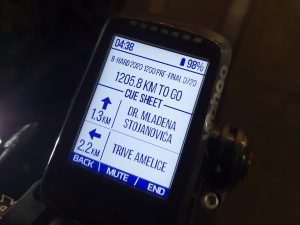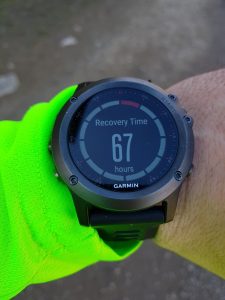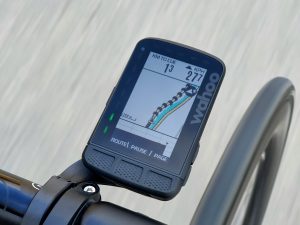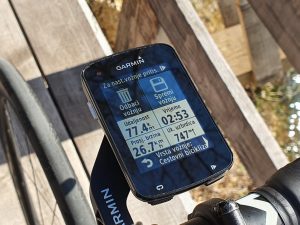I’m sure you know power, cadence, Strava and many more fancy words :)… but let’s go back to the beginning!
“How fast can you ride?”
 Legend has it that the creator of the first speedometer for a bicycle was not able to bear not having an answer to the constantly asked question of how fast can he ride and that he decided to find a suitable solution. OK, I have just made this up but the fact is that at some point it became very important for cyclists to know how fast they were riding and how far they had traveled, so the first mechanical or analog cycling computers were created. They were later replaced by digital ones, which were not much more advanced than watches, but in addition to the current speed and distance traveled, they had the ability to calculate the average riding speed, record the maximum speed and total mileage in the season. Then the possibility of monitoring the number of pedal revolutions was added, ie. cadence, as another parameter important for riding dynamics.
Legend has it that the creator of the first speedometer for a bicycle was not able to bear not having an answer to the constantly asked question of how fast can he ride and that he decided to find a suitable solution. OK, I have just made this up but the fact is that at some point it became very important for cyclists to know how fast they were riding and how far they had traveled, so the first mechanical or analog cycling computers were created. They were later replaced by digital ones, which were not much more advanced than watches, but in addition to the current speed and distance traveled, they had the ability to calculate the average riding speed, record the maximum speed and total mileage in the season. Then the possibility of monitoring the number of pedal revolutions was added, ie. cadence, as another parameter important for riding dynamics.
At some point, puls computers (i.e. heart rate monitors) made an appearance and soon thereafter more expensive cycling computers were expanded with this functionality, as well as with more elegant wireless speed and cadence sensors. At that time, all serious cyclists kept records of all training in notebooks, later in Excel, while the aforementioned more complex cycling computers later offered the possibility of saving records of rides and transferring data to an application on the computer, ie. electronic training log.
“Exit, stage left!”
 With the development of electronics and technology and the commercialisation of navigation devices, primarily based on GPS technology, at some point the manufacturers of cycling computers have managed to integrate this very useful feature into their products. Some did better in that game than others, so the market share of different brands changed very quickly. At the same time, online services such as Strava and RideWithGPS were created, so now with more advanced hardware we got adequate software, which completely changed the practice of tracking rides and training and shaped that segment of cycling into what we know it to be today. Of course, this was “sponsored” by the general expansion of recreational cycling at the world level. With the latest leap in technology, we now also have the ability to connect to power meters, smart trainers and wireless shifting systems (like the Shimano Di2) and a device like this can even act as your coach!
With the development of electronics and technology and the commercialisation of navigation devices, primarily based on GPS technology, at some point the manufacturers of cycling computers have managed to integrate this very useful feature into their products. Some did better in that game than others, so the market share of different brands changed very quickly. At the same time, online services such as Strava and RideWithGPS were created, so now with more advanced hardware we got adequate software, which completely changed the practice of tracking rides and training and shaped that segment of cycling into what we know it to be today. Of course, this was “sponsored” by the general expansion of recreational cycling at the world level. With the latest leap in technology, we now also have the ability to connect to power meters, smart trainers and wireless shifting systems (like the Shimano Di2) and a device like this can even act as your coach!
 However, the fact is that most riders (especially roadies) use GPS cycling computers mainly or even exclusively for recording their ride and uploading them to the aforementioned Strava or some other online service. The question then arises as to why we would not simply use a phone to record the rides (apart from the known elevation gain problems, due to the lack of a barometer), especially if we can now connect other sensors to it and we can also use it for navigation. The same question applies if you ride a bike only a few times a month – is it worth investing a significant amount of money into a GPS cycling computer? The answer is basically the same as for purchasing any other type of equipment – it is completely individual, but if you want maximum functionality, flexibility and ease of use (or simply “have to” keep up with trends) – then it definitely pays off, you just need select the appropriate device.
However, the fact is that most riders (especially roadies) use GPS cycling computers mainly or even exclusively for recording their ride and uploading them to the aforementioned Strava or some other online service. The question then arises as to why we would not simply use a phone to record the rides (apart from the known elevation gain problems, due to the lack of a barometer), especially if we can now connect other sensors to it and we can also use it for navigation. The same question applies if you ride a bike only a few times a month – is it worth investing a significant amount of money into a GPS cycling computer? The answer is basically the same as for purchasing any other type of equipment – it is completely individual, but if you want maximum functionality, flexibility and ease of use (or simply “have to” keep up with trends) – then it definitely pays off, you just need select the appropriate device.
GPS cycling computer or a multisport GPS watch?

After the appearance of heart rate monitors, they continued to develop in parallel with cycling computers. Thus, we have had multisport GPS watches on the market for a long time, which have practically got all the possibilities of GPS cycling computers, but their form is adapted for running, hiking, swimming and similar sports and above all for triathletes, because they can also be used on bicycles. Due to the limited size of the display, there is a slightly lower amount of information presented on the screen as well as diminished navigation functionality, but as a bonus you can also use this device as a regular watch :).
So, if your sports life is not limited to a bicycle, then this may be a great concept for you. However, if you spend a significant period of time on the bike during the week, then you should still opt (additionally or primarily) for a cyclocomputer.
The more the merrier?
In principle, all GPS cycling computers that we can find on the market today, from the basic models up, allow us to use them easily and provide practically everything that most cyclists need (and even more than that). How far we want to go with the investment depends on some additional options and characteristics, ie. whether you can live with a display a few tenths of an inch smaller or not :)). Joke aside, since many riders initially opt for used older devices, where not everything has been perfect, you should pay attention to the following when choosing a GPS cycling computer:

The size of the device and the display is directly proportional to the amount of parameters you can see on the display at the same time (is it important for you to see 3 or 13 parameters at any one time?) and limits the ability of navigational features (how often do you use maps?). Also, if you are a weight weenie, it is important to know that a larger device is both heavier and less aerodynamic.
In addition, we have monochrome and color displays, some older ones have no lighting or have poor contrast, slow response, etc. Another important thing is whether you like an idea of a touchscreen for this type of device or not and whether you want a “fancy” display of data or you want maximum simplicity and readability. All of these are some basic features that can and should be eliminatory when choosing a GPS cycling computer.
Internet connectivity – practically, this is the most important thing for us, so we could present our latest effort to the world as quickly and easily as possible :). Older devices require some sort of manual connection of the cycling computer to a desktop or laptop computer and transfer of data in this way (sometimes requiring the conversion of the data form itself), while modern cycling computers can automatically connect to WiFi and upload the data to your favorite service while you haven’t even had a chance to take your shoes off.
Battery capacity may be something that doesn’t matter to you if you ride 5-6 hours a week or have no issues charging your device after every ride. However, if you spend a lot of time on a bicycle or ride ultradistances and brevets – this can become very important to you. The same rule applies here as for any other electronic device and that is that better and more expensive devices also have better battery autonomy. With that in mind, make sure your device is able to function while connected to an external battery, as older models can only be charged while turned off and not during an activity, which can put you in an awkward situation when you least want it.
 Routing possibilities – a-ha, I was waiting for you there! As I’ve mentioned earlier, this is the least important segment for most riders when it comes to these devices, because realistically most cyclists usually ride on well-known local routes. However, if (or when) a need to use your cycling computer for navigation arises, ease of transferring routes to the cycling computer, ability to create routes on the go while riding (either on the cycling computer itself or via an application on the phone), ability to automatically recalculate and reroute when you deviate from the set route for one reason or another, map readability, timely and correct notifications, as well as – above all – stability of the device itself during the use of routing and active navigation – will become very important to you. So, if you are going to ride a brevet or simply like traveling and riding in destinations unknown to you – pay attention to this segment.
Routing possibilities – a-ha, I was waiting for you there! As I’ve mentioned earlier, this is the least important segment for most riders when it comes to these devices, because realistically most cyclists usually ride on well-known local routes. However, if (or when) a need to use your cycling computer for navigation arises, ease of transferring routes to the cycling computer, ability to create routes on the go while riding (either on the cycling computer itself or via an application on the phone), ability to automatically recalculate and reroute when you deviate from the set route for one reason or another, map readability, timely and correct notifications, as well as – above all – stability of the device itself during the use of routing and active navigation – will become very important to you. So, if you are going to ride a brevet or simply like traveling and riding in destinations unknown to you – pay attention to this segment.
As some of the additional options go, the most important ones to mention are active connection with a mobile phone, which allows you to receive various notifications, messages and phone calls, as well as an option to having live tracking of your location and riding parameters over the Internet, controlling the aforementioned smart trainers, notifying the selected phone number in case of a fall etc.
The price of the device and accompanying sensors can also prove to be very important, because there are cycling computers out there that may be more expensive than the bike you are currently riding. What is your priority in that case – decide for yourself :).
“You have arrived at your destination!”
 Given the very diverse offer, it is important to choose a device that suits your needs and not to adapt yourself to any given advice and – although some things can be concluded only after prolonged use of a certain device – you can find detailed tests and showcases of all possible devices on the Internet, so educate yourself well before buying.
Given the very diverse offer, it is important to choose a device that suits your needs and not to adapt yourself to any given advice and – although some things can be concluded only after prolonged use of a certain device – you can find detailed tests and showcases of all possible devices on the Internet, so educate yourself well before buying.
Of course, in the case of buying a used device, pay attention to the condition, as well as to which sensors you get with it, so that it does not turn out to be an expensive play in the end.
In any case, choose the basic criteria for a cycling computer and come to the ideal choice by doing an elimination system. Also, follow the rules for buying any type of equipment – it is better to be patient or pay extra for something that is high in quality and completely suitable for you, than to throw money at something that only half-suits you, is mediocre or a short-term solution.
There are loads of manufacturers out there, out of which we will point out Garmin and Wahoo Fitness as the most popular ones.
